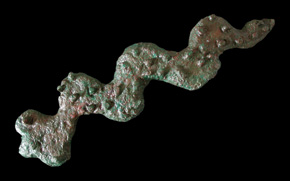
Bronze serpent with protuberant eyes. The sinuous body is decorated with circular elements in relief (l. 23 cm; w. 5.5 cm, th. 1.5 cm)
Worldwide, from prehistory to modern days, snakes have been linked to various meaning and endowed with different attributes, often ambiguous and contrasting with each other. As a result, their representation are extremely frequent and found on a number of different media.
Ancient Oman, and southeastern Arabia in general, was no exception. During the Iron Age, in fact, we assist to the spreading of snakes representations over the whole Oman peninsula, with evidence from numerous sites, among which Salut stands as one of the most impressive thanks to the association between the snake and the site’s architecture.
Copper snakes representations in full relief were among the first finds who raised the attention on southeast Arabia archaeology, as they were found in numbers at al-Qusais (Emirate of Dubai) on a site which was then referred to as the "mound of Serpents".
Similar ones have been unearthed at Salut: they can be either thick, rounded, cast pieces, or thin hammered metallic strips. In both instances, anatomical details are represented, as the mouth, the eyes, the scales on the body.
It can hardly be incidental that a similar copper snake was also found in proximity of the small shrine discovered on top of Jabal Salut, which can also be dated to the Iron Age.
Snakes were not only made in copper/bronze, but were also a common decorative motif for pottery, painted or as high-relief appliqués. Often they are found on large storage jars body, or crawling over the stands and cups of incense burners. The so called “long-handled bowls”, of which several specimens were found at Salut, often had the handle decorated with incised hatchings that recall snakes scales, in cases with the mouth and the eyes excised at the handle’s outer end.
In the absence of written sources it is difficult to grasp the actual meaning of the snake symbol, and to which aspects of life it was connected. Evidence from a number of sites could anyhow suggest that among its – likely numerous – significances, it was connected with metallurgy and water management and fertility.

